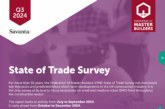
In the viewpoint column of PBM’s April 2021 edition, editor Paul Davies considered the findings of the magazine’s annual ‘Top 20’ listing of the UK’s largest merchant businesses, based on turnover calculations for the full calendar year of 2020.
In what can only be described as a truly unprecedented year, it has been fascinating to receive the responses from the businesses that make up the sector’s ‘Top 20 merchants’ and feature in the issue’s centre-page pull-out supplement. With the listing based on turnover figures, focusing purely on the numbers reveals a curiously mixed picture as to how these leading players managed through a year dominated by the Covid-19 pandemic — with trading significantly disrupted for all, those seeing turnover rise and those seeing it fall actually balance out with ten up, and ten down.
Dig a little deeper, and this disparity can in part be explained as the consequence of all the factors one would see in a ‘normal’ year — plans to rationalise the scale and scope of existing branch networks; mergers and demergers; expansion and acquisition programmes; diversification into new areas; the influence of politics, policy and the economy… Put another way, despite the direct impact of coronavirus, there was plenty about 2020 that remained ‘business as usual’.
Of course, none of this is to diminish the very real effect of the crisis on trading. One way or another, all of our respondents reflected upon the requirement to essentially transform their business models pretty much overnight (literally…) and the impact on operations from late March last year simply, obviously, cannot be exaggerated.
Equally, many paused to consider how the emergency measures they implemented allowed for a second half performance that began to make up for the losses. Digitalisation and ecommerce initiatives, from click and collect services to full online transactions, were commonly seen to help fill the breach — Travis Perkins, for example, notes that online sales increased 18% to £57m in its P&H division whilst Huws Gray said that “online sales more than tripled in 2020 as a direct impact of Covid-19”.
Yet for all the justifiable headlines about the rise of ecommerce, it should not be overstated that a lot of the surging recovery since the summer was the result of endeavours ‘on the ground’. From managing ‘contactless’ traffic flow and loading in the yard, to implementing the required safety measures in branch, the sector was able to rise to the challenge.
Perhaps the real point then, is not that ecommerce is the sole direction of travel and more that the nation’s merchants have shown the flexibility to respond to the evolving needs of their customers — from ceding ground to the pureplay digital operators, there is now an effective online proposition; for the more ‘traditional’ customers who still want the welcoming, efficient and knowledgeable service they receive in branch, that choice emphatically remains available.
A related point is that our Top 20 chart illustrates the ongoing evolution of the sector, and it is becoming increasingly difficult to describe a ‘typical’ merchant business. The broad size and scale of the various businesses that feature is not the issue; similarly, we have often discussed the notion of what doesn’t constitute a merchant business even in an ever-changing landscape.
What is interesting is that we are seeing businesses grow — and trade — in numerous different ways. A developing focus on ‘retail’ areas such as showrooms is one, not least with general ‘non-professional’ sales a significant factor in lockdown as furlough and working from home led to a DIY boom that merchants were willing and able to capitalise on. On this, ecommerce has helped open the door, but additional trade solutions such as timber engineering, electrical wholesale arms and broader wholesale operations feature ever more strongly throughout the Top 20.
Whilst this arguably makes it more difficult to deliver a comparative analysis, we actually feel this allows our listing to provide a much more substantial industry benchmarking barometer — and one that truly reflects the underlying strength and diversity of the companies making up the merchant sector as a whole.
“One way or another, all of our respondents reflected upon the requirement to essentially transform their business models pretty much overnight (literally…) and the impact on operations from late March last year simply, obviously, cannot be exaggerated.”









